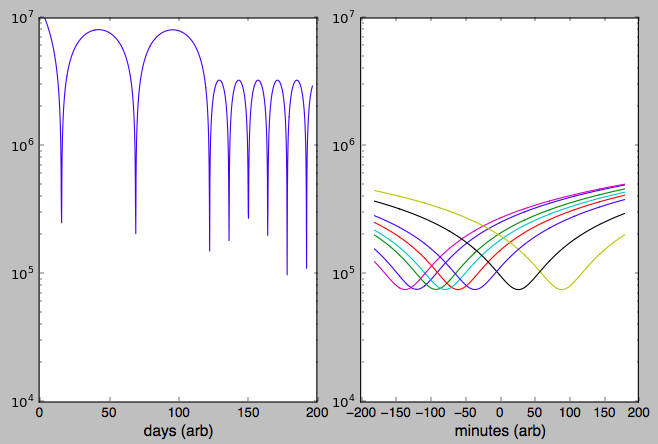Because of the slow helium valve responses, Juno was not instructed to execute the large delta-v maneuver to drop from the ~53 day orbit to the ~14 day orbit originally scheduled for 2016-Oct-19.
I'd originally extracted the planned orbit from JPL Horizons mentioned here months ago. Now it's gone - or at least I can't find it. I'd like to retrieve it again as an exercise to understand it.
Just for one example, for this question I'd like to use Horizons to quickly give me the approximate orbital elements (a and $\epsilon$ at least) for the 14 day orbits around Jupiter. I can figure out how to extract them from the state vectors but it would be great to use this handy system.
Trajectory name Start (TDB) Stop (TDB)
------------------------------ ----------------- -----------------
rec_110805_111026_120302 2011-Aug-05 17:19 2011 OCT 26 00:00
rec_111026_120308_120726 2011 OCT 26 00:00 2012 MAR 08 12:00
rec_120308_120825_121109 2012 MAR 08 12:00 2012 AUG 25 00:00
rec_120825_130515_130708 2012 AUG 25 00:00 2013 MAY 15 00:00
rec_130515_131005_131031 2013 MAY 15 00:00 2013 OCT 05 12:00
rec_131005_131014_131101_reco 2013 OCT 05 12:00 2013 OCT 14 00:01
rec_131014_131114_140222 2013 OCT 14 00:01 2013 NOV 14 06:00
ref_131114_171017_140311_V0.2 2013 NOV 14 06:00 2015 MAR 26 00:00
ref_150326_180221_150326_V0.1 2015 MAR 26 00:00 2016 FEB 26 00:01
ref_160226_180221_160226_V0.1 2016 FEB 26 00:00 2016 APR 13 18:00
pre_160413_161016_160818_pj01_V0.1 2016 APR 13 18:00 2016 OCT 16 23:00
ref_160226_180221_160226_V0.5 2016 OCT 16 23:00 2018 FEB 21 11:40
Now the last two lines are:
pre_160413_161016_160818_pj01_V0.1 2016 APR 13 18:00 2016 JUL 29 21:00
nob_160729_170201_161019.V0.1 2016 JUN 29 21:00 2017 FEB 01 00:00
Primary question: I would like to access the original reference orbit before the update. Is there any way I can get it again using Horizions? I'd like to get state vectors with fine granularity using the original ref_160226_180221_160226_V0.5 throughout all of 2017 at least. Is there any way to do this through the web, or telnet, or by e-mail?
Secondary question: If you look at the tables, the trajectories are patched - date/time that one ends matches the date/time the next begins, except sometimes for an overlap of 00:01 (a minute) which could be rounding in the table display.
However, in the last two lines of the updated table, the second-to-last line ends at 2016 JUL 29 21:00 while the last line begins one month earlier at 2016 JUN 29 21:00. Is this a typographical error, or are they somehow averaged together during that month?
above: Calculated distance between Juno Spacecraft and Jupiter Barycenter from JPL Horizons. Thin (blue) line: original reference orbit, Thick (green) line: updated orbit shown until 2016-Dec-10 - roughly when final committment for orbit "lowering" burn must be made. Note - data was downloaded at 2 hour time-point spacing, so uneven minimum distances is due to coarse sampling of the incredibly fast flyby.
It is the data of the thin (blue) line I would like to access again.


sk = SpiceKernel('spk_ref_160226_180221_160226.bsp')fails with "ValueError: SPK data type 1 not yet supported segment" $\endgroup$